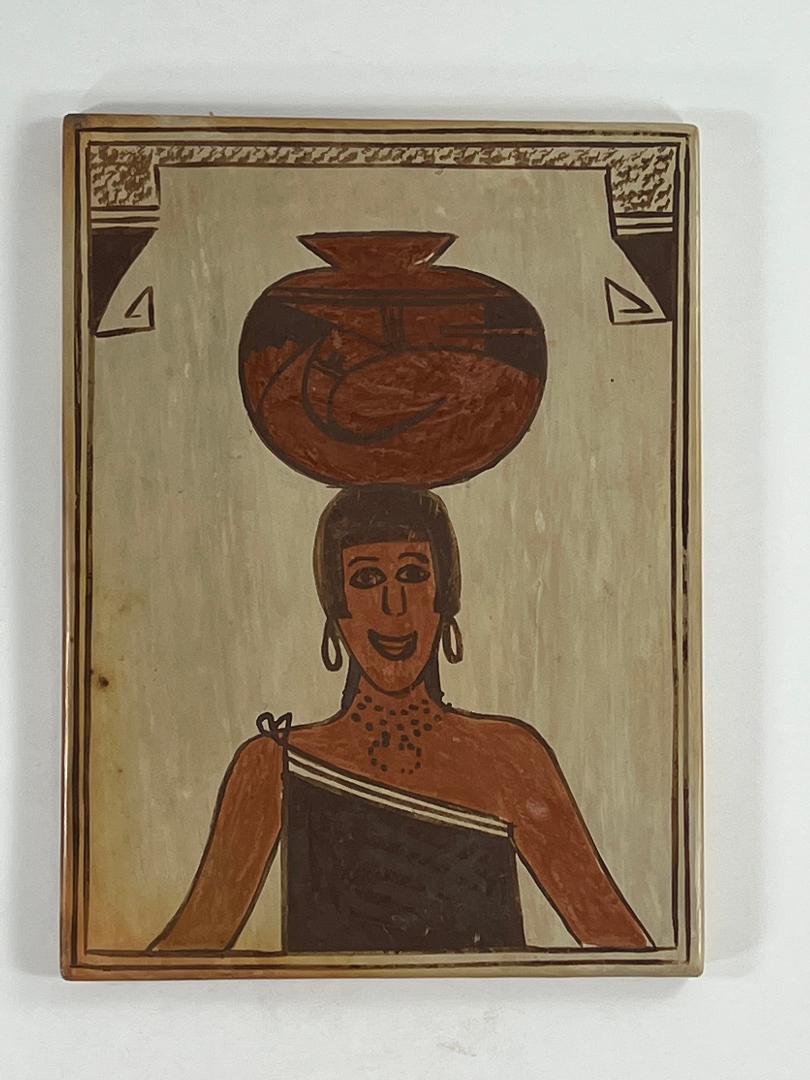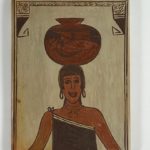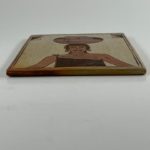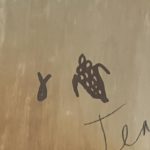Framed in a doorway, this smiling woman balances a very large Hopi pot on her head. Born in 1948, Jean began making pottery when she was about 17 had a long and productive pottery-making career, including this tile. She was named an “Arizona Living Treasure” in 2014. She no longer makes pottery. I imagine her as the woman pictured here, showing her pottery and pleased.
Form:
Although seemingly a simple shape, tiles are ornery since the wet clay tends to warp as it dries. Tile 2022-04, although larger than average, is almost completely flat. The striations from polishing are clear, on both front and back. The color of the front is a very light tan, with only some light blushing on the edges. Shards are used to shelter pottery from direct contact with the clay. The back of tile 2022-04 is scorched from where the flames touched the clay.
Design:
The top edge of the front of the tile displays a thin stippled beam with large square ends. Pendant to these ends are downward-facing, black, right triangles. From their tips thin triangular crooks with three turns point to the center of the tile. This design frames the main image on the tile in a sort of doorway.
The woman is dressed in a simple manta tied on her right shoulder, its upper edge a striped design. Around her neck is a necklace, probably Navajo, with a naja pendant. Her long hair is tied behind her head and flows down her back, indicating her status as a married woman. Loop earrings adorn her ears. She is dressed in a traditional pueblo style.
Her face is clearly delineated; her broad smile lighting up her features. Balanced on her head is a very large pot with a red surface displaying a version of the “bird hanging from sky band” design.
Design analysis:
I have seen very similar tiles by Jean that were made in 1995, so that is perhaps a good guess for the production date of this tile. One is depicted in Allan and Carol Hayes’ book Pottery of the Southwest (2012), page 30. Tiles by Jean were used to decorate the renovated restrooms at the Museum of Northern Arizona in Flagstaff. When I travel with friends in the southwest, these restrooms are always on my “must see” list, a curious recommendation, I suppose.
I know the women at Acoma and Zuni will ceremonially parade carrying large ollas on their heads, but I have not heard of such a procession at Hopi. Nevertheless, this Hopi woman’s pleasure is visually tied to both the beautiful pot on her head and her success in balancing it there. Her smile is infectious.
In a book she published privately in 2011, Jean reflected on her place in her family’s pottery-making tradition:
“I was born at the base of First Mesa in my family home. My [great-great] grandmother was Nampeyo, the great Tewa potter…I take pride in knowing that I am one of her descendants who continues her legacy by using traditional methods and incorporating visual elements of her style into my work.
My family heritage is handed down through the generations and I believe my obligation is to carry on this legacy so it is not lost. Carrying on the tradition involves long hours of loving labor, but it gives meaning and value to my life. It is a gift to me from the grandmothers that has supported and sustained me all my life. Making pottery has been good to me. I find it fulfilling and I honor the grandmothers who taught me the traditional way (2011:2).”
So that’s why the woman on the tile is smiling.





